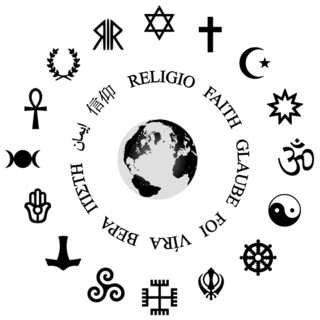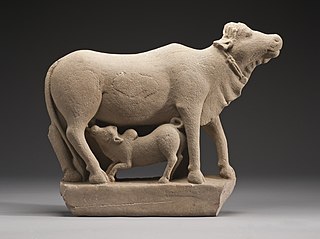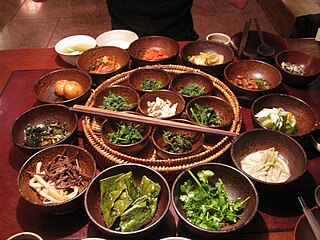
Ahimsa is the ancient Indian principle of nonviolence which applies to actions towards all living beings. It is a key virtue in Indian religions like Jainism, Buddhism, Hinduism, and Sikhism.

Buddhist cuisine is an Asian cuisine that is followed by monks and many believers from areas historically influenced by Mahayana Buddhism. It is vegetarian or vegan, and it is based on the Dharmic concept of ahimsa (non-violence). Vegetarianism is common in other Dharmic faiths such as Hinduism, Jainism and Sikhism, as well as East Asian religions like Taoism. While monks, nuns and a minority of believers are vegetarian year-round, many believers follow the Buddhist vegetarian diet for celebrations.

Jainism, also known as Jain Dharma, is an Indian religion. Jainism traces its spiritual ideas and history through the succession of twenty-four tirthankaras, with the first in the current time cycle being Rishabhadeva, whom the tradition holds to have lived millions of years ago, the twenty-third tirthankara Parshvanatha, whom historians date to the 9th century BCE, and the twenty-fourth tirthankara Mahavira, around 600 BCE. Jainism is considered an eternal dharma with the tirthankaras guiding every time cycle of the cosmology. Central to understanding Jain philosophy is the concept of bhedvigyān, or the clear distinction in the nature of the soul and non-soul entities. This principle underscores the innate purity and potential for liberation within every soul, distinct from the physical and mental elements that bind it to the cycle of birth and rebirth. Recognizing and internalizing this separation is essential for spiritual progress and the attainment of samyak darshan or self realization, which marks the beginning of the aspirant's journey towards liberation. The three main pillars of Jainism are ahiṃsā (non-violence), anekāntavāda (non-absolutism), and aparigraha (asceticism).

The five precepts or five rules of training is the most important system of morality for Buddhist lay people. They constitute the basic code of ethics to be respected by lay followers of Buddhism. The precepts are commitments to abstain from killing living beings, stealing, sexual misconduct, lying and intoxication. Within the Buddhist doctrine, they are meant to develop mind and character to make progress on the path to enlightenment. They are sometimes referred to as the Śrāvakayāna precepts in the Mahāyāna tradition, contrasting them with the bodhisattva precepts. The five precepts form the basis of several parts of Buddhist doctrine, both lay and monastic. With regard to their fundamental role in Buddhist ethics, they have been compared with the Ten Commandments in Abrahamic religions or the ethical codes of Confucianism. The precepts have been connected with utilitarianist, deontological and virtue approaches to ethics, though by 2017, such categorization by western terminology had mostly been abandoned by scholars. The precepts have been compared with human rights because of their universal nature, and some scholars argue they can complement the concept of human rights.

The following outline is provided as an overview of and topical guide to religion:
Ātman is a Sanskrit word for the true or eternal Self or the self-existent essence or impersonal witness-consciousness within each individual. Atman is conceptually different from Jīvātman, which persists across multiple bodies and lifetimes. Some schools of Indian philosophy regard the Ātman as distinct from the material or mortal ego (Ahankara), the emotional aspect of the mind (Citta), and existence in an embodied form (Prakṛti). The term is often translated as soul, but is better translated as "Self", as it solely refers to pure consciousness or witness-consciousness, beyond identification with phenomena. In order to attain moksha (liberation), a human being must acquire self-knowledge.

Nonviolence is the personal practice of not causing harm to others under any condition. It may come from the belief that hurting people, animals and/or the environment is unnecessary to achieve an outcome and it may refer to a general philosophy of abstention from violence. It may be based on moral, religious or spiritual principles, or the reasons for it may be strategic or pragmatic. Failure to distinguish between the two types of nonviolent approaches can lead to distortion in the concept's meaning and effectiveness, which can subsequently result in confusion among the audience. Although both principled and pragmatic nonviolent approaches preach for nonviolence, they may have distinct motives, goals, philosophies, and techniques. However, rather than debating the best practice between the two approaches, both can indicate alternative paths for those who do not want to use violence.

Indian philosophy consists of philosophical traditions of the Indian subcontinent. The philosophies are often called darśana meaning, "to see" or "looking at." Ānvīkṣikī means “critical inquiry” or “investigation." Unlike darśana, ānvīkṣikī was used to refer to Indian philosophies by classical Indian philosophers, such as Chanakya in the Arthaśāstra.

There are varying beliefs about cattle in societies and religions.

A lacto-vegetarian diet is a diet that abstains from the consumption of meat as well as eggs, while still consuming dairy products such as milk, cheese, yogurt, butter, ghee, cream, and kefir, as well as honey.
The Eastern religions are the religions which originated in East, South and Southeast Asia and thus have dissimilarities with Western, African and Iranian religions. Eastern religions include:

The practice of vegetarianism is strongly linked with a number of religious traditions worldwide. These include religions that originated in India, such as Hinduism, Jainism, Buddhism, and Sikhism. With close to 85% of India's billion-plus population practicing these religions, India remains the country with the highest number of vegetarians in the world.

A śramaṇa is a person "who labours, toils, or exerts themselves for some higher or religious purpose" or "seeker, one who performs acts of austerity, ascetic". The śramaṇa tradition includes primarily Jainism, Buddhism, and others such as the Ājīvika.
Anekāntavāda is the Jain doctrine about metaphysical truths that emerged in ancient India. It states that the ultimate truth and reality is complex and has multiple aspects and viewpoints.

Buddhist vegetarianism is the practice of vegetarianism by significant portions of Mahayana Buddhist monastics and laypersons as well as some Buddhists of other sects. In Buddhism, the views on vegetarianism vary between different schools of thought. The Mahayana schools generally recommend a vegetarian diet, claiming that Gautama Buddha set forth in some of the sutras that his followers must not eat the flesh of any sentient being.

Buddhist ethics are traditionally based on the enlightened perspective of the Buddha. In Buddhism, ethics or morality are understood by the term śīla or sīla (Pāli). Śīla is one of three sections of the Noble Eightfold Path. It is a code of conduct that emulates a natural inborn nature that embraces a commitment to harmony, equanimity, and self-regulation, primarily motivated by nonviolence or freedom from causing harm. It has been variously described as virtue, moral discipline uprightness and precept, skillful conduct.

The position and treatment of animals in Buddhism is important for the light it sheds on Buddhists' perception of their own relation to the natural world, on Buddhist humanitarian concerns in general, and on the relationship between Buddhist theory and Buddhist practice.

In Jainism, ahiṃsā is a fundamental principle forming the cornerstone of its ethics and doctrine. The term ahiṃsā means nonviolence, non-injury, and absence of desire to harm any life forms. Veganism, vegetarianism and other nonviolent practices and rituals of Jains flow from the principle of ahimsa. There are five specific transgressions of Ahimsa principle in Jain scriptures – binding of animals, beating, mutilating limbs, overloading, and withholding food and drink. Any other interpretation is subject to individual choices and not authorized by scriptures.

Diet in Hinduism signifies the diverse traditions found across the Indian subcontinent. Hindu scriptures promote a vegetarian dietary ideal based on the concept of ahimsa—non-violence and compassion towards all beings. According to a Pew Research Center survey, 44% of Hindus say they are vegetarian.
Biocentrism, in a political and ecological sense, as well as literally, is an ethical point of view that extends inherent value to all living things. It is an understanding of how the earth works, particularly as it relates to its biosphere or biodiversity. It stands in contrast to anthropocentrism, which centers on the value of humans. The related ecocentrism extends inherent value to the whole of nature.

















